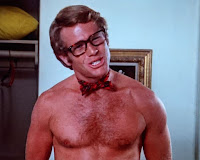I'd seen both these Peter Bogdanovich movies many years ago and saw them again recently after he passed on. Both are similar in terms of genre (in the neighborhood of screwball comedy), and both have plots that more or less resist summary—in fact, the plots almost feel beside the point—so I'm combining my comments here. DOC is an uncredited remake of 1938's BRINGING UP BABY, the archetypal screwball comedy. Barbra Streisand takes the Katherine Hepburn role of the insistent free-spirited young woman who takes an unprovoked shine to a buttoned-down, glasses-wearing scientist (here, Ryan O'Neal; in 1938, Cary Grant) and wears him down enough so that he leaves his uptight fiancée and takes a chance on future happiness with her. The 'screwball' label fits both the heroine, who is about as whacky as you can stand, but also the fast pace of the movie, with jokes and slapstick shots arriving like clockwork every few minutes. I'm not a fan of BABY but I find Streisand and O'Neal just charming enough that I wasn't climbing the wall at their incessant antics—though, to be honest, this is not a movie I could re-visit very often. The supporting cast is led by the delightful Madeleine Kahn in her first movie (Blazing Saddles and Young Frankenstein would soon follow) and also features Austin Pendleton, Liam Dunn (stealing his scenes as a judge), Mabel Albertson, Michael Murphy, Sorrell Booke, and M. Emmet Walsh. I admit to being totally smitten with the nerdish cuteness of O'Neal here (pictured at left), and I find Streisand uses an admirably light touch, something she doesn't wield too often, to make her potentially unlikable character almost likable.
Three years later, Bogdanovich's career went into a nosedive with AT LONG LAST LOVE, in which tribute is paid to both the screwball comedy and 1930s musical romances. What may have tripped Bogdanovich up is the fact that the Fred Astaire and Ginger Rogers movies, the golden standard of 30s musical romances, were not screwball comedies; they were romantic comedies and had some eccentric characters and situations, but they were not paced at a breakneck speed, and the focus was always on the musical numbers. Oh, and, yes, the Astaire/Rogers movies had actors who could sing and dance, and the critical consensus at the time was that this movie was a bomb because most of the actors could do neither terribly well. It's difficult to get around that criticism. What I will say is that most of the singing isn't exactly awful, just amateurish. The main actors in this foursome roundelay are Burt Reynolds, Cybill Shepherd, Duilio Del Prete, and Madeline Kahn. The plot (as in WHAT'S UP, DOC?) is more or less immaterial to the movie; suffice to say that four upper-crust folks (or upper-crust wannabes) fall in love, provoke jealousies, and generally behave in wacky ways as they constantly sing and dance to the songs of Cole Porter. Shepherd is a good singer but has a hard time pulling off the casual, improvised-feeling tone of the conversation scenes. Reynolds gets by on his easy charm, but indeed cannot sing very well. Del Prete is kind of a washout; he's not a great singer and has a rather flat personality. Kahn sings fine but feels weighed down by the shortcomings of the others—all the characters act like they are half-drunk on champagne all the time, but the actors are working too hard to achieve that feeling effectively. Honestly, the actors who come out of this the best are John Hillerman and Eileen Brennan as a valet and a maid who slowly fall in love. Neither is known as a singer but they come across well, and Hillerman in particular is great fun as he enacts and enlarges on the uptight Eric Blore persona from the Astaire movies.
Now let me get to the biggest problems with this movie. The iffy singing and the stiff acting are magnified by Bogdanovich's mannered style. He deliberately shot in very long single takes, eschewing close-ups or 2-shots (2 faces sharing the frame). It's fun for a while but it clearly takes its toll on the actors who have to deliver lots of fast-paced dialogue, and begins to feel repetitive and artificial. Bogdanovich's biggest mistake, however, was having the cast sing live. Adding live singing to long takes really does the movie in. With actors known for singing, this might have worked, but it does these folks no favors, though Shepherd and Hillerman handle the singing best. The look of the movie—it's in color but it's all blacks, whites, grays and silvers—is great and Cole Porter's songs are fun, though there are too many of them; it feels like there are more sung lyrics than spoken dialogue. This was probably intentional on Bogdanovich's part but it works against any real character depth, to the point where we just don't care about the outcome of any of the pairings. I hadn't seen this movie since the early 80s when it was on cable, and the only print I had access to now was a bootleg on YouTube which is a faulty transfer and is missing the last 10 minutes or so. I'd be happy to watch it "officially" again if I ever get the chance. Pictured are Shepherd, Reynolds and Kahn.



.jpg)








